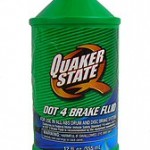Trailer Brake Fluid tips from Tie Down Engineering
 Tie Down Engineering recommends changing brake fluid every two years for marine trailers and every three years for utility trailers.
Tie Down Engineering recommends changing brake fluid every two years for marine trailers and every three years for utility trailers.
Brake fluid is one of the most neglected fluid in vehicles today, yet is vitally important for safe towing. Consequently, trailer owners should check the fluid in both the tow vehicle and the trailer on a regular basis. The brake fluid should be changed if it is contaminated. The issue is that old brake fluid may not be safe if moisture contamination is above a certain level.
Many experts have long recommended changing the brake fluid every year or two for preventative maintenance. Their rationale is based on the fact that glycol-based brake fluid (DOT 3 & 4) starts to absorb moisture from the moment it is put in the system. The fluid attracts moisture through microscopic pores in seals and exposure to the air. The problem is obviously worse in wet climates where humidity is high and with marine trailers constantly subjected to dunking in lakes, rivers or oceans.
DOT 5 cannot be used in trailer brake systems unless specifically stated by the actuator and brake manufacturer. DOT 5 does not absorb water, however the silicone in the DOT 5 makes the seals swell and can bind up caliper pistons.
Silicone has several other properties that make it less then desirable for trailer use. When forced thru small orifices under high pressure, like the solenoid valves in a disc brake system, it tends to foam, generating bubbles. Bubbles in brake fluid make for spongy brakes. Silicone also tends to become slightly compressible at temperatures near its boiling point, which makes it generally inappropriate for trailers used in mountain conditions. Tie Down Engineering brakes are designed for DOT3 or DOT 4 fluid ONLY. NEVER USE DOT 5.
Water can actually cause air to accumulate in your brake lines. Brake fluid is hygroscopic. It absorbs and retains water. The problem arises when the fluid has absorbed as much water as it possibly can and becomes saturated. Brake fluid is designed to have an extremely high boiling point; however, if you subject your tow vehicle and trailer to excessive braking, such as a trip through the mountains, you can easily cause the brake fluid to heat up to this temperature or beyond. When the brake fluid boils, especially when there is excessive water in the system, steam is a by-product. The braking system ultimately compresses this steam and turns it into water. The air separates from the water creating large pockets of air in your brake lines.
After only a year of service, the brake fluid in the average marine trailer may contain as much as two percent water. After 18 months, the level of contamination can be as high as three percent. And after several years of service, it is not unusual to find brake fluid that contains as much as seven to eight percent water.
As the concentration of moisture increases, it causes a sharp drop in the fluid’s boiling temperature. Brand new DOT 3 brake fluid must have a dry (no moisture) boiling point of at least 401 degrees F, and a wet (moisture-saturated) boiling point of no less than 284 degrees. Most new DOT 3 fluids exceed these requirements and have a dry boiling point that ranges from 460 degrees up to over 500 degrees.
Only one percent water in the fluid can lower the boiling point of a typical DOT 3 fluid to 369 degrees. Two percent water can push the boiling point down to around 320 degrees, and three percent will take it all the way down to 293 degrees, which is getting dangerously close to the minimum DOT and OEM requirements.
So consider this: After three years of service, the average boiling point of the brake fluid has dropped to a potentially dangerous level because of moisture contamination and may not meet minimum federal requirements for brake fluid.
Water Contamination increases the danger of brake failure because vapor pockets can form if the fluid gets too hot. Vapor displaces fluid and is compressible, so when the brakes are applied the actuator may completely compress without applying the brakes!
In addition to the safety issue, water-laden brake fluid promotes corrosion and pitting in caliper pistons and bores, wheel cylinders, master cylinders, steel brake lines and reverse solenoids.
From time to time we hear about reports of “unexplained” brake failures. When the vehicle’s brakes are inspected, no apparent mechanical fault can be found. The fluid level is normal, the linings are within specifications, the hydraulics appear to be working normally. Yet the brakes failed. Why? Because something made the brakes hot, which in turn overheated the fluid causing it to boil. The underlying cause often turns out to be dragging brakes caused by the E-stop cable being tripped, or the use of DOT 5 Fluid, but that is another story.